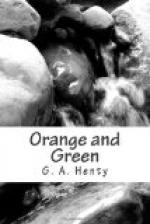In Scotland, the Jacobite spirit was gathering in strength, and William knew that, unless he speedily broke the strength of James’s party in Ireland, he would very shortly be confronted with difficulties and dangers on all sides.
The position which the Irish army occupied was a strong one. Its right rested upon Drogheda, a strong town in their possession. In front was the Boyne, with steep banks lined with thick hedges, with cottages scattered here and there, offering an excellent position for light troops. On the left, the Boyne turned almost at a right angle, and formed a defence on this flank. To the rear, the Irish position was covered by high hills and the village of Donore. Further back was the pass of Duleek. The hedges and cottages by the river side were occupied by the Irish infantry, and upon some little hillocks, which ran along the water’s edge, they erected some light batteries.
King William reconnoitred the position with great attention, and saw that it had been well chosen, and its advantages turned to account. Notwithstanding the reports of deserters and others, he showed much anxiety to determine the exact strength of the Irish. After examining the position for some time from a height, he rode down towards the river, accompanied by several of his officers. When within musket shot of the bank, near the ford and village of Old Bridge, he perceived that a small island in the Boyne was occupied by a party of the Irish horse. Near the ford some field works had been thrown up. It was at this point that the king determined to cross the river, and he spent some time conversing with his officers, as to the arrangements for the passage.
He then rode slowly along the river bank, until he arrived nearly opposite the left of the Irish line. Here he alighted from his horse, and sat down on rising ground, watching his own battalions, which were marching, with the greatest regularity and order, into the positions assigned to them.
While he was so engaged, some officers of James’s army were observed, riding quietly along the opposite bank of the river, and also engaged in watching the movements of the British troops. These were General Sarsfield, the Duke of Berwick, the Marquis of Tyrconnell, the Count de Lauzun, and others. Some of the English dragoons approached the river, and were fired upon by the Irish. They returned the fire, and, while the attention of both sides was engaged by the skirmish, a party of Irish cavalry moved slowly down towards the river and halted behind a low hedge, and then, wheeling about, again retired.
The movements of the king, and the group of officers accompanying him, had been observed in the Irish army, and two field pieces were sent down, concealed in the centre of the cavalry. The guns had been placed behind the hedge when the horsemen withdrew, and, when William rose from the ground and mounted his horse, fire was opened. The first cannon shot killed two horses, and a man by his side. The next grazed the king’s right shoulder, tearing away his coat and inflicting a slight flesh wound. Had the aim been slightly more accurate, or had the gunners fired with grape, instead of round shot, it is probable that the whole course of history would have been changed.




